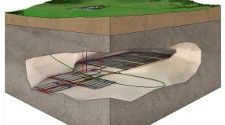
A Quintessa-Golder team, working as part of the Nucleus Alliance, are supporting Radioactive Waste Management Limited (RWM) in an exploration of how the requirements of the EU Groundwater Daughter Directive (GWDD) might be met for the proposed Geological Disposal Facility (GDF).
The Water Framework Directive (2000/60/EC; WFD) and the Groundwater Daughter Directive (2006/118/EC; GWDD) require EU Member States to protect groundwater against pollution and deterioration by preventing or limiting entry of pollutants (substances liable to cause pollution) to groundwater.
In May 2019, a Nucleus Alliance report was published describing a study covering the development of a non-radiological pollutant screening methodology and a scoping level total system model (TSM) to support exploration of how the requirements of the GWDD might be met for the GDF.
As part of this study, we developed and applied a pollutant screening methodology and then modified the 2016 generic Disposal System Safety Case (gDSSC) TSM to include non-radiological pollutants. Key changes were to the discretisation of the geosphere to allow the concentrations of non-radiological pollutants to be outputted at locations along the flow path and to add additional contaminants and processes necessary to represent non-radiological pollutants.
The model results for RWM's higher strength and lower strength sedimentary host rocks were compared with comparison values (water quality standards considered to be protective of groundwater quality). They demonstrated that key uncertainties in the results relate to:
- degradation rates of organic pollutants: these rates are not well characterised for conditions likely to be encountered in the GDF’s near field but they are important in determining how much, if any, of the organic pollutants might be released from the GDF;
- waste package failure times: when combined with the degradation behaviour are significant in determining how much, if any, of the organic pollutants might be released from the GDF and the rates of release;
- solubility and sorption parameters: these influence the concentrations observed in groundwater and may be poorly known for some of the non-radiological pollutants; and
- inventory: the current Derived Inventory does not quantify the inventory of several non-radiological pollutants that were judged to be potentially important.
RWM is taking forward these new avenues of investigation with support from the Nucleus Alliance team.